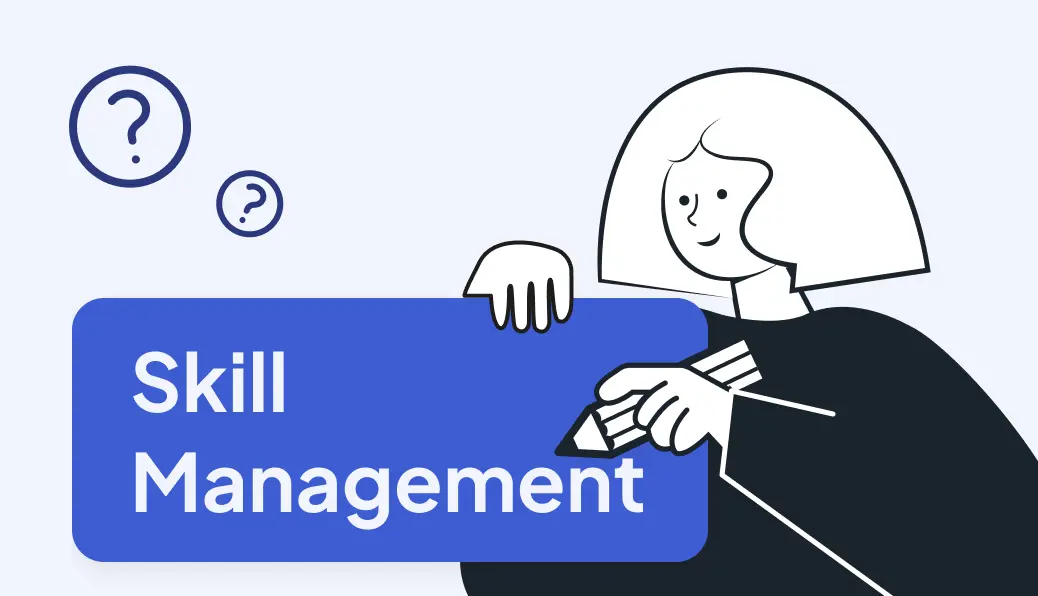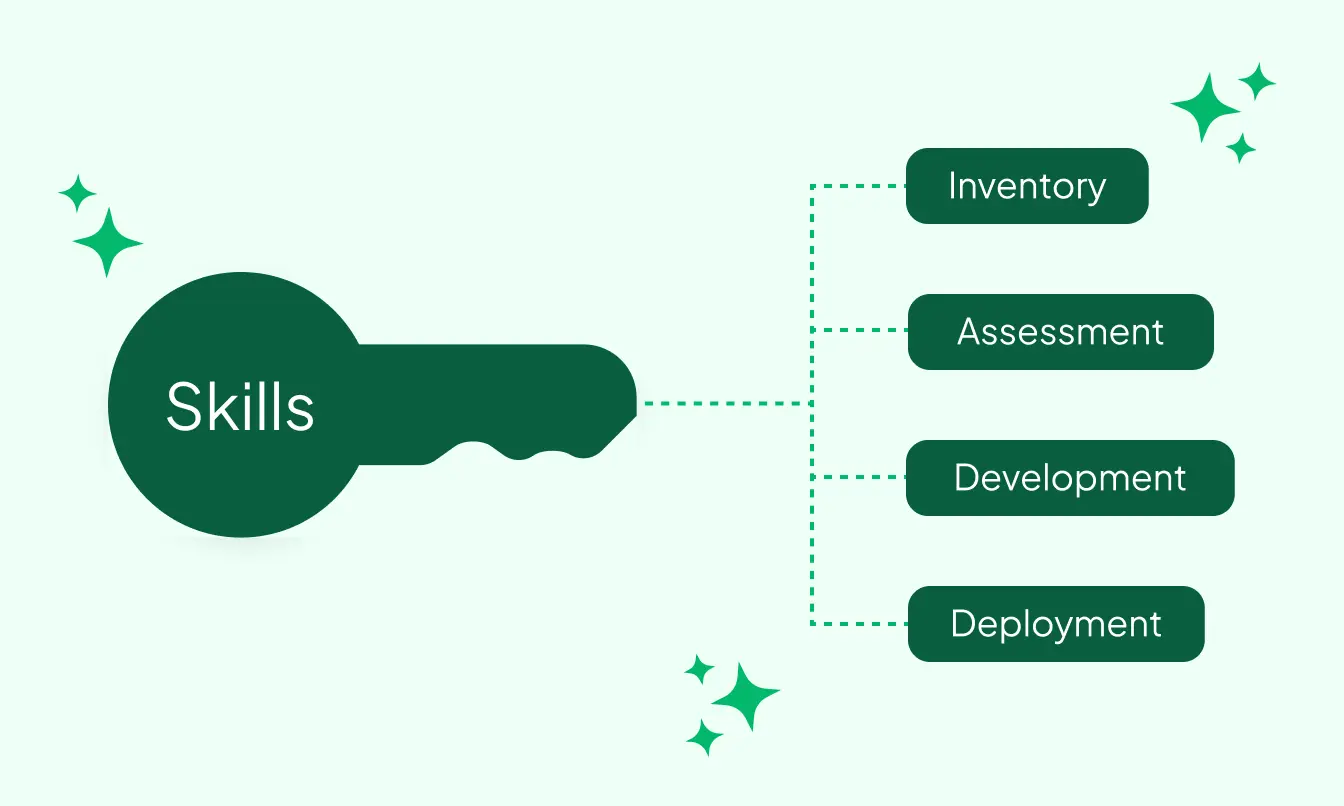
What Is Skills Management: A Comprehensive Guide


- Why Is Skills Management Important?
- What Is The Skills Management Method: Components!
- Looking For Enhanced Skill Management Results?
- The Role of a Skill Management Software In Your Org
- To Sum Up
Unsurprisingly, your workforce’s skill sets define your organization’s status broadly. But how would you know everything about your employees’ capabilities and potential?
Skill management is more than a buzzword in today’s fast-paced business world: it is the process of comprehending your employees’ skills and deploying their needed abilities in your company to unleash your best possible outcomes.
Employers assign different job positions according to their candidates’ skill sets, but assessing many individuals for various positions is not always easy.
This is where skills management plays a crucial role in individual development and organizational success by selectively choosing the right staff for the challenges at hand and pointing out the needs and possible flaws.
We will proceed to discuss what is skills management and its components to uncover your team’s hidden potential and learn how skill management will lead your organization to a more prosperous future.
Our skills management software offers you a great opportunity to enhance employee engagement and productivity.
Why Is Skills Management Important?

But what is the skills management method, and why is it significant? As a supportive tool, skill management is the cornerstone of HR management to boost your organization and utilize your staff’s skill sets.
We will explore some of the significant advantages of skill management to better understand this system’s necessity:
1. Enhance Performance
Nothing engages an employee more than a sense of belonging!
When you find the right skills and requirements for a position, you will assign that role to the most competent candidate.
Employees with a proper and efficient skill set are more engaged and productive. Therefore, your team will have a higher quality of work.
2. Increased Retention Rate
Misidentifying an employee’s talents may cause frustration for you and them since the job isn’t exactly suitable for their skills.
Comprehending what is a skills management system and investing in such tools will lead your organization to more specifically categorized skill groups, and prevents you from assigning an unfitting position to an employee.
Nevertheless, a skill management system doesn’t always result in keeping an employee since it genuinely reveals their aptitude and benefit to the organization.
- Case Study: Netflix 🎬
Being a well-known streaming and movie production company, Netflix pioneered the development of the “Keeper Test” program.
Reportedly, Netflix encourages growth opportunities to develop “future stars from current players”.
The Keeper Test includes one simple question for the team leaders about each of their team members: “If a team member was leaving for a similar role at another company, would you (as their manager) try to keep them?”
The test result indicates that if a leader is not willing enough to fight for their employee, it’s time to let that employee go.
3. Improved Company Culture
According to some organizational studies by Oxford Business School in 2019 and some older research by Warwick University based on a 2015 paper, happy employees work harder, making them around 13% more productive than others.
Skills management leads to correct role distribution and an improved work environment and company culture. An improved company culture creates a more productive workforce.
4. Creating An Innovative Workforce
If you have previously done a skills analysis, you must know that a job position doesn’t solely define an employee!
Each team member is a combination of skill sets, personality traits, hidden talents, etc.
A skill management software demonstrates an individual's talent and potential in every area of your organization.
This system lets you realize how much time and money an employee will save you regarding your future recruitment.
5. Competency Mapping
This particular skill management benefit is mainly for healthcare, welfare, or manufacturing organizations. These industries require very specific qualifications for their positions since there are risks of fatality with their jobs.
When it comes to competency mapping, it’s important to ask “What are skill systems?” to dive deeper into an organization’s workforce and provide various approaches and systems to select the best skills and candidates.
An organized map of your team’s skills and capabilities helps you decide who is the most qualified to fill a position in your organization. Competency plays a major factor in life-or-death carriers.
Moreover, a skills chart provides you with 2nd and 3rd best options if your first employee takes a sick day, a parental leave, another position, etc.
- Case Study: Apple 🍏
Apple highly focuses on succession plan strategies to groom potential employees for leadership positions.
Their program includes a variety of approaches, such as mentorship, stretch assignments, and leadership development programs.
Tim Cook, the current CEO of Apple Inc., declared that Apple allocates considerable resources to succession plans.
Cook stated, “Because something that's unpredictable can always happen, and I can step off the wrong curb tomorrow—I pray that doesn't happen.”
What Is The Skills Management Method: Components!

What is employee skill management, and how is it created?
Four significant steps constitute a thoroughly done skill management.
Leaving out any of these components from your management program will withhold you from a resourceful analysis.
1. Skills Inventory
You need to gather a thorough database of your workforce’s skill sets. These abilities form a wide range, from technical and soft to leadership skills.
Skills inventory helps you have a comprehensive picture of your staff’s full potential and the various possibilities they bring.
The skills collection is a general step, indicating a load of unorganized data.
You must gather all of your employees’ skills. We typically categorize skill sets into three groups:
- Domain Knowledge: You should assess the professional knowledge your employee has acquired during their job or training. Knowledge is the premise of technical skills.
- Hard Skills: The necessary skills an employee learns during practice are called technical or hard skills. Hard skills are an essential part of later evaluation.
- Soft Skills: An employee’s behavior, attitude in the workplace, teamwork potential, and other personal traits are considered soft skills.
There are some basic questions to review your skills inventory to check if you have everything:
- What sets of skills will your employee need in the future to do their job properly?
- Are there any skill gaps or emerging obstacles in their performance? If yes, how can you support an approach to address it?
- How are your employee’s existing skills supporting your team or organization?
2. Skill Assessment
This step requires you to evaluate each employee’s proficiency level in their different skills.
This component will give you a clearer view of your organization’s potential. This step lets you identify skill gaps within your employees, departments, etc.
Companies like IBM use complex analytics tools to uncover their skill gaps and future talent needs to stay ahead of their competitors.
You can benefit from performance reviews, assessment interviews, and feedback strategies to gain worthwhile information for a thorough evaluation.
Gathering and analyzing different skill groups is a challenging job.
You will need a fully organized and understandable overview of your employees’ skills to enhance your organizational status further.
- How Would a Skills Matrix Help?
Even though some roughly implementable approaches exist to collect and review your team’s skills, we suggest using a Skill Matrix Tool as a specifically designed piece of software to meet your requirements and elevate your company’s performance.
Our Skill Matrix Software offers a thorough yet organized skills inventory. We collect a resourceful database for your team’s skill sets through 360-degree and individual feedback. Skills Matrix Software helps you combine the first and second steps for a more complete and easy operation to target your company’s goals.
With agyleOS we provide you with your employees' specifically designed assessment chart so the development strategies and organizational purposes will be clearly seen.
A skill matrix software helps you apply a thorough skills management method for better productivity and management.
3. Skills Development
This step requires you to take action on the basis of the skill management’s data to enhance employee development, including skill gaps, emerging malfunctions, and other pending issues.
You should also exploit training programs, coaching, mentoring, and other growth opportunities to plan your team’s performance strategy.
- Case Study: Amazon 📦

Amazon introduced its “Career Choice” program as a development plan to empower its staff. Launched in 2012, the Career Choice program offers employees the opportunity to teach their highly demanded skills both within and outside the organization.
This program has long encouraged the workforce to pursue their passion and enhance their skills for better career growth opportunities.
4. Skills Deployment
After thoroughly examining your organization's status and planning an approach for skills development, you must align your staff’s skills with their career growth and overall organizational goals.
As different roles require different qualifications, a perceptive leader knows the secret to success lies within their team’s capabilities.
An organization will unleash its full potential by correctly deploying its employees’ current (or enhanced) skill sets.
Looking For Enhanced Skill Management Results?
By understanding the preceding chapters on what is skills management and following the primary steps of the procedure, you now have the recipe for an acceptable meal.
However, you always need extra flavoring pro tips for a magnificent dish.
We suggest you note the following aspects when applying a skill management system:
🔁 Continuous assessment:
A one-time skill assessment is good. However, for a more thorough experience, you must track your employees’ trends, gaps, and developments.
🪡 Personalized Development Plans:
Every employee and their needs are unique. You must tailor specific growth programs for them to enhance their skills.
Moreover, a personalized plan ensures your employee of their value in your team.
💪🏼 Encourage Teamwork:
By promoting knowledge-sharing, collaboration, and mentorship between team members, you will establish a more positive environment, strengthening learning.
- Case Study: Google 🔍
Google is a pioneer in skill management tricks! They invented their G2G (Googler to Googler) program in 2007.
This training program encourages employees to share their skills with each other through mentoring sessions.
This development plan not only improves the overall staff’s knowledge but also fosters a positive work culture for learning and growth.
📝 Plan With Rationale:
Use the data and analytics from the skill management system to discover your team’s potential strengths.
A Skill management software reveals insights into your employee skills that will lead you toward a performance peak.
The Role of a Skill Management Software In Your Org

Skill management systems provide sufficient information to identify and assess the skill sets of your workforce.
By having a better and more comprehensive image of your employees, you will plan better strategies and more specific positions in your company.
A thorough skill management analysis gains numerous worthy data. Let us explore a few:
1. Skills Tracking:
A skill management software enables you to have a repository of your team’s skills, certifications, and overall competencies.
2. Skill Gap Analysis:
If there is any existing distance between an employee’s current and optimum skills, skill management software will discover it and inform you about it.
3. Training Programs:
After analyzing the skill gaps, you must plan for different approaches to enhance your employee performance.
A skills management software lets you schedule, track, and assess the programs to ensure their effectiveness for employee skills.
4. Strategic Alignment:
Assigning each individual’s proficiency level with performance evaluations, skill management software finds the most productive approaches for you to match an employee with a position.
Skills Management Platform includes discovering your workforce's existing abilities, skill gaps, and growth opportunities.
With agyleOS, we help you implement strategic data to bridge gaps through training programs, align proficiencies with talent acquisition, get analytic reports on your team’s status, and bring order to your company.
All to help you build a more powerful team for a promising future.
To Sum Up
Skill management is not just an abstract concept; it is a means of strategy for organizations to thrive in a speedingly competitive environment.
Companies can unlock their employees’ full potential by comprehending the importance and components of skill management software and following the pro tips.
Through real-life and widely-known examples such as Google, Amazon, Apple, or Netflix, you can see that even the leading organizations are leveraging HR matters like skill management to foster a better work environment, productivity, and profitability.
Candidly speaking, investing in your employees’ skills and their development by mastering skill management techniques is the key to unleashing your organization’s hidden talents.
Whether you long for a positive company culture, continuous learning environment, career development, or more profit, skill management is your lead to soar over your rivals.
By submitting this form, I confirm that I have read the privacy policy and that I consent to the processing of my personal data by agyleOS for the purposes stated. In the event of consent, I can revoke my consent at any time. Furthermore, by submitting the form, I agree to the general terms and conditions.


- Product
- Resources
- Compare
- Company
